JOURNALIST REPORTS 11-13 JAN 2022
PEDRO JOSÉ-MARCELLINO, XO/CJ CREW 238
MDRS — Crew 238 — Sol 09 11 Jan 2022
The Tasmanian devil, the devil’s toenails, and the solar flares
Yesterday, not for the first time, I was up into the wee hours, trying to catch up on all the admin due at MDRS, and with my reporting duties outside of the station. Planning, logistics, domestic labour, reports, reportages, and collective projects have all taken a toll on my sleep hours. Read: I haven’t had many.
Mind you, as a tv producer, the overloaded schedule is nothing new. But I confess the utter exhaustion caused by the intensity of life at MDRS, the lack of time and space to rest, and even the lack of privacy, which has clear impacts on personal well-being, did catch me off guard. As a crew with a core focus on mental health, we took note of this.
As an XO and Crew Journalist on crew 238, you’d reckon I know everything that is going on. Turns out, that’s not true. The morning of Sol 9 was a perfect example. As I left my stateroom still rubbing my eyes, I grab a coffee and suddenly hear this German accent coming through the radios: “Commander! Commande! We’ve received a notification of a solar flare. ETA is 20 minutes. I repeat: ETA is 20 minutes. Seek shelter!”.
We all look at each other, roll our eyes, and then dutifully march down the stairs, slowly and in a controlled manner. Eng. Werner reminds us of the need to carry supplies, notably water and some easy-opening food. We do. Some of us also grab their spirulina tubes. Not all. As we are sheltering and Werner goes through whatever supplies we collectively selected, we do notice we have twelve radios and one space novella, and five spirulina tubes. Prokywka, the mother of the spirulina, has forgotten her tube at the Hab, to die of intense solar radiation. Sad.
When the exercise is done, we resume our life at the station. Some have admin, others have domestic tasks, others have Braided Communications sessions with our off-site communications and systems engineer, Bhargav Patel, the newspaper we’re reporting to, or our loved ones (part of the mental health study at City – University of London).
In the PM, the crew splits, and for the first time, the boys go out on an EVA together, to Barainca Butte. A long drive, but it’s an incredibly beautiful site with a handful of geological features we can’t get over. On the way back, Eng. Werner happens upon a treasure trove of devil’s toenails, and you suddenly see the decades of amateur geology and paleontology knowledge shine through on his face — “how did these get here!?” The landscape carved by water streams provides useful clues. On the way back we stop at Kissing Camel to admire a few incredible features, upon which the sunset is bestowing a golden glory. We park the rovers just on time.
At the dinner table, the conversation is lighthearted, and given our cultural and geographical diversity, we try to explain the difference between Tasmanian devils, North American wolverines, gophers marmots, prairie
dogs, martens, minks, weasels, and so on. Someone mentions all these critters are cousins of Alice-the-desert-mouse. And suddenly, our commander screams, then I scream, Pokrywka laughs to the point of crying, and Werner thinks it’s all a practical joke. But it’s not. Our commander swears she saw a large beast. Pokrywka believes it’s little Alice again. Every time we mention her, she surfaces.
Over dinner, the commander takes a different seat so she won’t unwittingly see this monster again. It’s dessert time when another scream scares all of us again. This time we know it’s Alice, coming out of Eng. Werner’s stateroom. She was caught there once before. The live traps come back out.
These Martian rodents are too much.
MDRS — Crew 238 — Sol 10 12 Jan 2022
Going to The Moon to find Gypsum as in Mars
Dr. Sandor gifted us with an after-dinner chamomile infusion last night, and we all slept in. It’s 9 AM when we all show up for breakfast, after a relaxing night. The next two days have been planned as slightly more low-key events, with half the crew resting in each of them. It’s been intense to this point.
On my end, I am putting my logistical and journalistic duties aside for a couple of days, and setting up a temporary studio at the RAM, to record one-on-one interviews with our incredible, multi-hyphenate
crew. Our diversity of cultures, geographies, professional backgrounds, experiences, opinions, and philosophies make this the most interesting groups of individuals I’ve ever gone to Mars with.
A group that can both accomplish unique, ground-breaking, challenging research, but also philosophically question and defend interplanetary expansion, structures of power, and the public narratives that surround it. But even this stellar crew needs a day off. So: slow day.
Some of us head over to our last rover-based EVA to The Moon area, which provides a spectacular backdrop to our geological observation and documentary captures. The commander finds the dark gray landscape menacing and observes Pokrywka and me as we venture through the myriad of flood channels. Werner had returned from this location with plenty of surface gypsum, a soft sulfate mineral composed of calcium sulfate dihydrate, which some scientists believe to be a core indicator of historic running water on parts of Mars identified by Opportunity.
On our analog Mars, gypsum glitters at sunset, and I happened upon a little deposit at the top of the hill we climbed back on.
The return to the Hab is rough. It’s a long drive, the path is bumpy, and all our six radios fail, leaving us to communicate by sign language when we are utterly exhausted. Not fun. But this evening we get to kick back. It’s my turn cooking, and it’s do-it-yourself burrito night. We also bring out a geological map of Mars puzzle
(hard), and the Oculus Quest 2 of our partners Stardust Technologies, a Canadian startup working on improving the mental health of astronauts. Dr. Sandor and our commander explore meditation and go to bed as if they had chamomile tea. Eng. Werner explores the award-winning ISS walk and is animated. I feel dizzy after 2 minutes.
MDRS — Crew 238 — Sol 11 13 Jan 2022
The Spirulina Harvest and Alice’s (Re)Capture
I have been visiting Dr. Sandor at the GreenHab over the last few days, early in the morning. The smell of the GreenHab (and frankly, Dr. Sandor herself) reminds me of my grandmother, and the love she has for the plants in there shows through. The GreenHab is looking gorgeous after two weeks in her hands, playing them music — folk music one day, Albinioni the next, jazz the next one. As I’m there, I noticed Pokrywka’s spirulina bubbling on the shelf. We call her on the radio and ask for instructions. We hear giggling on the other side, and she says, seriously enough: “please evacuate the GreenHab immediately! It’s an invasion!” We keep our humour.
Today was a second quiet day, with half the crew staying in on R&R. I filmed the last of my three interviews in my impromptu RAM studio, and as I was wrapping my self-interview, I see the last rover EVA leave to Candor Chasma. They return with spectacular footage and photos. But while they are away, Commander Robinson informs me that we are having one more emergency drill organized by Eng. Werner. This time, a tunnel depressurization was caused by debris impacts. He expects one breach.
I see an opportunity to get him back and apply 7 impact sites with blue paper tape. When they are back, Werner and Turner are rushed to the tunnels to fix the breaches. They are spread all over, and the alerts keep coming. One is bigger than he thought and threatens the collapse of this section of the station. Werner fixes it in the nick of time and looks happy. “Cool”, he says. Werner is happy, I’m happy.
Before dinner, Pokrywka decides is time to harvest the spirulina tubes. Some are healthier than others, laying bare the different parenting methods. The commander readily wins with her spirulina called The Borg. She has been referring to herself and the spirulina as “we” for days now. A few died undignified deaths. We ate the rest.
We admit that our giving names to these test tubes and a desert mouse indicate that isolation has affected us.
Speaking of Alice: she was recaptured in the live-trap, and we will let her go on Sol 12.


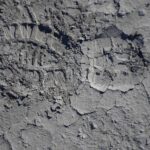
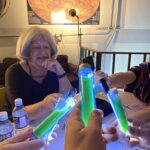
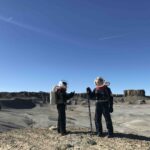
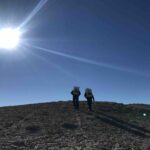
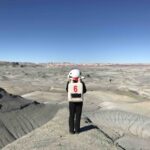
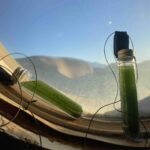
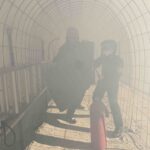
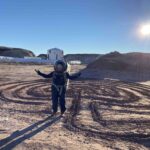
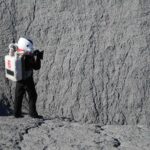
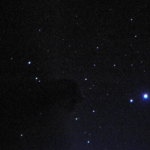
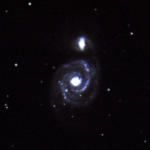
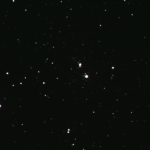
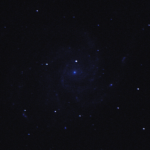
You must be logged in to post a comment.